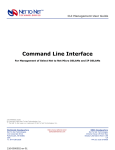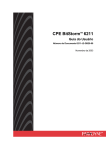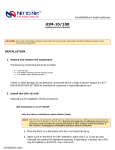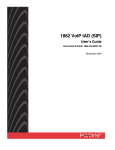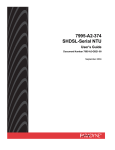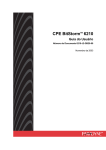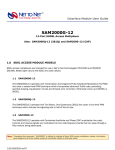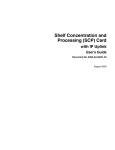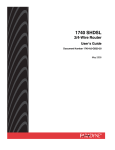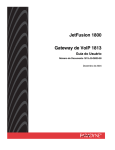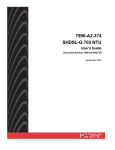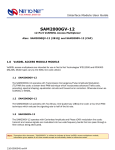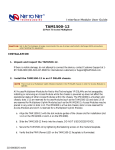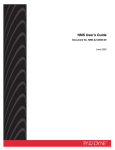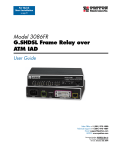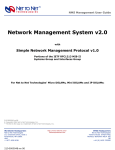Download Command Line Interface
Transcript
Command Line Interface for 12000 and 4000 BACs, Micro DSLAMs, and Network Extenders User’s Guide Document No. CLI-A2-GB20-00 October 2004 Copyright © 2004 Paradyne Corporation. All rights reserved. Printed in U.S.A. Notice This publication is protected by federal copyright law. No part of this publication may be copied or distributed, transmitted, transcribed, stored in a retrieval system, or translated into any human or computer language in any form or by any means, electronic, mechanical, magnetic, manual or otherwise, or disclosed to third parties without the express written permission of Paradyne Corporation, 8545 126th Ave. N., Largo, FL 33773. Paradyne Corporation makes no representation or warranties with respect to the contents hereof and specifically disclaims any implied warranties of merchantability or fitness for a particular purpose. Further, Paradyne Corporation reserves the right to revise this publication and to make changes from time to time in the contents hereof without obligation of Paradyne Corporation to notify any person of such revision or changes. Changes and enhancements to the product and to the information herein will be documented and issued as a new release to this manual. Warranty, Sales, Service, and Training Information Contact your local sales representative, service representative, or distributor directly for any help needed. For additional information concerning warranty, sales, service, repair, installation, documentation, training, distributor locations, or Paradyne worldwide office locations, use one of the following methods: Internet: Visit the Paradyne World Wide Web site at www.paradyne.com. (Be sure to register your warranty at www.paradyne.com/warranty.) Telephone: Call our automated system to receive current information by fax or to speak with a company representative. — Within the U.S.A., call 1-800-870-2221 — Outside the U.S.A., call 1-727-530-2340 Document Feedback We welcome your comments and suggestions about this document. Please mail them to Technical Publications, Paradyne Corporation, 8545 126th Ave. N., Largo, FL 33773, or send e-mail to [email protected]. Include the number and title of this document in your correspondence. Please include your name and phone number if you are willing to provide additional clarification. Trademarks Acculink, BitStorm, Comsphere, DSL the Easy Way, ETC, Etherloop, FrameSaver, GranDSLAM, GrandVIEW, Hotwire, the Hotwire logo, Jetstream, MVL, Net to Net Technologies, NextEDGE, OpenLane, Paradyne, the Paradyne logo, Paradyne Credit Corp., the Paradyne Credit Corp. logo, Performance Wizard, StormPort, TruePut are all registered trademarks of Paradyne Corporation. ADSL/R, Connect to Success, Hotwire Connected, iMarc, JetFusion, JetVision, MicroBurst, PacketSurfer, Quick Channel, ReachDSL, Reverse Gateway, Spectrum Manager, and StormTracker are trademarks of Paradyne Corporation. All other products or services mentioned on the Paradyne Web site are the trademarks, service marks, registered trademarks, or registered service marks of their respective owners. A October 2004 CLI-A2-GB20-00 Contents About This Guide 1 Document Purpose and Intended Audience . . . . . . . . . . . . . . . . . . . . v Document Summary . . . . . . . . . . . . . . . . . . . . . . . . . . . . . . . . . . . . . . v Product-Related Documents . . . . . . . . . . . . . . . . . . . . . . . . . . . . . . . . v Command Line Interface . . . . . . . . . . . . . . . . . . . . . . . . . . . . . . . . . . . 1-1 System Requirements . . . . . . . . . . . . . . . . . . . . . . . . . . . . . . . . . . . . . 1-1 Multi-User Support. . . . . . . . . . . . . . . . . . . . . . . . . . . . . . . . . . . . . 1-1 Default Settings . . . . . . . . . . . . . . . . . . . . . . . . . . . . . . . . . . . . . . . . . . 1-2 CLI User Access Defaults . . . . . . . . . . . . . . . . . . . . . . . . . . . . . . . 1-2 System Defaults. . . . . . . . . . . . . . . . . . . . . . . . . . . . . . . . . . . . . . . 1-2 Port Defaults . . . . . . . . . . . . . . . . . . . . . . . . . . . . . . . . . . . . . . . . . 1-2 Device Memory . . . . . . . . . . . . . . . . . . . . . . . . . . . . . . . . . . . . . . . . . . 1-3 Local Files . . . . . . . . . . . . . . . . . . . . . . . . . . . . . . . . . . . . . . . . . . . . . . 1-3 IP DSLAM Data Management . . . . . . . . . . . . . . . . . . . . . . . . . . . . . . . 1-4 Replacing an Interface Module . . . . . . . . . . . . . . . . . . . . . . . . . . . 1-4 Replacing a Multiplexer Uplink Module (MUM) . . . . . . . . . . . . . . . 1-4 System Reset/Reboot . . . . . . . . . . . . . . . . . . . . . . . . . . . . . . . . . . . . . 1-5 Manual Reset. . . . . . . . . . . . . . . . . . . . . . . . . . . . . . . . . . . . . . . . . 1-5 Reset Via CLI. . . . . . . . . . . . . . . . . . . . . . . . . . . . . . . . . . . . . . . . . 1-5 Clearing NVRAM . . . . . . . . . . . . . . . . . . . . . . . . . . . . . . . . . . . . . . . . . 1-5 Manual Clear . . . . . . . . . . . . . . . . . . . . . . . . . . . . . . . . . . . . . . . . . 1-5 Clear NVRAM Via CLI . . . . . . . . . . . . . . . . . . . . . . . . . . . . . . . . . . 1-5 CLI Overview 2 3 COM Port Connection Connecting a PC . . . . . . . . . . . . . . . . . . . . . . . . . . . . . . . . . . . . . . . . . 2-1 Launching Your Terminal Emulator . . . . . . . . . . . . . . . . . . . . . . . . . . . 2-2 Logging In . . . . . . . . . . . . . . . . . . . . . . . . . . . . . . . . . . . . . . . . . . . . . . 2-2 CLI Prompt . . . . . . . . . . . . . . . . . . . . . . . . . . . . . . . . . . . . . . . . . . . . . . 2-2 CLI Commands CLI-A2-GB20-00 Command Syntax. . . . . . . . . . . . . . . . . . . . . . . . . . . . . . . . . . . . . . . . . October 2004 3-1 i Contents Command Errors . . . . . . . . . . . . . . . . . . . . . . . . . . . . . . . . . . . . . . . . . 3-1 Command History . . . . . . . . . . . . . . . . . . . . . . . . . . . . . . . . . . . . . . . . 3-1 Back. . . . . . . . . . . . . . . . . . . . . . . . . . . . . . . . . . . . . . . . . . . . . . . . 3-1 Forward . . . . . . . . . . . . . . . . . . . . . . . . . . . . . . . . . . . . . . . . . . . . . 3-2 Disable Commands . . . . . . . . . . . . . . . . . . . . . . . . . . . . . . . . . . . . . . . 3-2 Disable Telnet . . . . . . . . . . . . . . . . . . . . . . . . . . . . . . . . . . . . . . . . 3-2 Disable TFTP. . . . . . . . . . . . . . . . . . . . . . . . . . . . . . . . . . . . . . . . . 3-2 Disable Web Server. . . . . . . . . . . . . . . . . . . . . . . . . . . . . . . . . . . . 3-2 Enable Commands. . . . . . . . . . . . . . . . . . . . . . . . . . . . . . . . . . . . . . . . 3-2 Enable Telnet. . . . . . . . . . . . . . . . . . . . . . . . . . . . . . . . . . . . . . . . . 3-2 Enable TFTP . . . . . . . . . . . . . . . . . . . . . . . . . . . . . . . . . . . . . . . . . 3-3 Enable Web Server . . . . . . . . . . . . . . . . . . . . . . . . . . . . . . . . . . . . 3-3 SET Commands . . . . . . . . . . . . . . . . . . . . . . . . . . . . . . . . . . . . . . . . . . 3-3 System Configuration. . . . . . . . . . . . . . . . . . . . . . . . . . . . . . . . . . . . . . 3-4 IP Address . . . . . . . . . . . . . . . . . . . . . . . . . . . . . . . . . . . . . . . . . . . 3-4 Subnet Mask . . . . . . . . . . . . . . . . . . . . . . . . . . . . . . . . . . . . . . . . . 3-4 Gateway. . . . . . . . . . . . . . . . . . . . . . . . . . . . . . . . . . . . . . . . . . . . . 3-5 CLI Session Timeout . . . . . . . . . . . . . . . . . . . . . . . . . . . . . . . . . . . 3-5 Inband Management . . . . . . . . . . . . . . . . . . . . . . . . . . . . . . . . . . . 3-5 Inband Management VLAN ID. . . . . . . . . . . . . . . . . . . . . . . . . . . . 3-6 Password . . . . . . . . . . . . . . . . . . . . . . . . . . . . . . . . . . . . . . . . . . . . 3-6 SNMP Community String. . . . . . . . . . . . . . . . . . . . . . . . . . . . . . . . 3-7 System Name . . . . . . . . . . . . . . . . . . . . . . . . . . . . . . . . . . . . . . . . 3-7 Port Configuration . . . . . . . . . . . . . . . . . . . . . . . . . . . . . . . . . . . . . . . . 3-8 Backbone-VLAN . . . . . . . . . . . . . . . . . . . . . . . . . . . . . . . . . . . . . . 3-8 Flood . . . . . . . . . . . . . . . . . . . . . . . . . . . . . . . . . . . . . . . . . . . . . . . 3-9 Priority . . . . . . . . . . . . . . . . . . . . . . . . . . . . . . . . . . . . . . . . . . . . . . 3-10 VLAN Range . . . . . . . . . . . . . . . . . . . . . . . . . . . . . . . . . . . . . . . . . 3-10 ADSL Commands . . . . . . . . . . . . . . . . . . . . . . . . . . . . . . . . . . . . . . . . 3-13 ADSL Encapsulation . . . . . . . . . . . . . . . . . . . . . . . . . . . . . . . . . . . 3-13 ADSL Port Mode . . . . . . . . . . . . . . . . . . . . . . . . . . . . . . . . . . . . . . 3-13 ADSL Standard . . . . . . . . . . . . . . . . . . . . . . . . . . . . . . . . . . . . . . . 3-14 VPI and VCI . . . . . . . . . . . . . . . . . . . . . . . . . . . . . . . . . . . . . . . . . . 3-14 VPI/VCI Detect. . . . . . . . . . . . . . . . . . . . . . . . . . . . . . . . . . . . . . . . 3-15 SDSL Commands . . . . . . . . . . . . . . . . . . . . . . . . . . . . . . . . . . . . . . . . 3-16 SDSL Line Code . . . . . . . . . . . . . . . . . . . . . . . . . . . . . . . . . . . . . . 3-16 Show Commands . . . . . . . . . . . . . . . . . . . . . . . . . . . . . . . . . . . . . . . . . 3-17 Show Command Example . . . . . . . . . . . . . . . . . . . . . . . . . . . . . . . 3-17 Show All. . . . . . . . . . . . . . . . . . . . . . . . . . . . . . . . . . . . . . . . . . . . . 3-18 Firmware Version. . . . . . . . . . . . . . . . . . . . . . . . . . . . . . . . . . . . . . 3-19 ii October 2004 CLI-A2-GB20-00 Contents Independent Commands . . . . . . . . . . . . . . . . . . . . . . . . . . . . . . . . . . . 3-20 Allow. . . . . . . . . . . . . . . . . . . . . . . . . . . . . . . . . . . . . . . . . . . . . . . . . . . 3-20 Clear NVRAM . . . . . . . . . . . . . . . . . . . . . . . . . . . . . . . . . . . . . . . . 3-21 Disable Telnet . . . . . . . . . . . . . . . . . . . . . . . . . . . . . . . . . . . . . . . . 3-21 Disable TFTP. . . . . . . . . . . . . . . . . . . . . . . . . . . . . . . . . . . . . . . . . 3-21 Disable Web Server. . . . . . . . . . . . . . . . . . . . . . . . . . . . . . . . . . . . 3-21 Enable Telnet (Default) . . . . . . . . . . . . . . . . . . . . . . . . . . . . . . . . . 3-21 Enable TFTP (Default). . . . . . . . . . . . . . . . . . . . . . . . . . . . . . . . . . 3-22 Enable Web Server (Default). . . . . . . . . . . . . . . . . . . . . . . . . . . . . 3-22 Help . . . . . . . . . . . . . . . . . . . . . . . . . . . . . . . . . . . . . . . . . . . . . . . . 3-22 Logout . . . . . . . . . . . . . . . . . . . . . . . . . . . . . . . . . . . . . . . . . . . . . . 3-23 Reset . . . . . . . . . . . . . . . . . . . . . . . . . . . . . . . . . . . . . . . . . . . . . . . 3-23 Who . . . . . . . . . . . . . . . . . . . . . . . . . . . . . . . . . . . . . . . . . . . . . . . . 3-23 Index CLI-A2-GB20-00 October 2004 iii Contents iv October 2004 CLI-A2-GB20-00 About This Guide Document Purpose and Intended Audience This guide describes the use of the Command Line Interface (CLI) for Network Extenders, micro DSLAMs, and interface modules in 12000/4000 Broadband Access Concentrators. Document Summary Section Description Chapter 1, CLI Overview Provides background information about the devices that use the CLI. Chapter 2, COM Port Connection Describes how to connect a PC to the COM port of your DSLAM or Network Extender. Chapter 3, CLI Commands Describes the CLI commands. Index Lists key terms, concepts, and sections in alphabetical order. A master glossary of terms and acronyms used in Paradyne documents is available online at www.paradyne.com. Select Support → Technical Manuals → Technical Glossary. Product-Related Documents Complete documentation for Paradyne products is available online at www.paradyne.com. Select Support → Technical Manuals. To order a paper copy of a Paradyne document, or to speak with a sales representative, please call 1-727-530-2000. CLI-A2-GB20-00 October 2004 v About This Guide vi October 2004 CLI-A2-GB20-00 CLI Overview 1 Command Line Interface Paradyne’s 12000/4000 Series Broadband Access Concentrators, micro DSLAMs, and Network Extenders can be managed with a Command Line Interface (CLI) through either a direct PC to DSLAM COM (Communication) Port connection or from a remote network connection via Telnet. System Requirements Straight-Through RJ45 to RJ45 Ethernet Cable Required for establishing a direct connection from the COM port to your PC for initial configuration via CLI. DB9 Female to RJ45 Male Adapter Required for conversion of your PC's RS232 serial port for use with an RJ45 to RJ45 Ethernet cable. Included with select devices. Terminal Emulator Required for running CLI. Any standard terminal emulator currently on the market will serve the purpose; there are no specific program requirements. Telnet Tool Required for remote management with CLI. Microsoft Windows Operating Systems (1998, 2000, NT and XP) include a Telnet tool which is run through the Windows command prompt (cmd.exe). If you are using an operating system other than Windows, you may need to install a Telnet tool. Any standard Telnet tool currently on the market will serve the purpose; there are no specific program requirements. Trivial File Transfer Protocol (TFTP) Tool Required for downloading firmware updates and for saving DSLAM configurations to local files for backup and/or template use. Any standard TFTP tool will serve the purpose; there are no specific program requirements. Multi-User Support Up to 10 CLI connections can run concurrently: 1 direct connection via the COM Port and up to 9 remote connections via Telnet. There are two classes of CLI users: Superuser (read/write), and General User (read only). Both classes may be logged in simultaneously. CLI-A2-GB20-00 October 2004 1-1 1. CLI Overview Default Settings No configuration is necessary for a DSLAM or Network Extender to operate at default settings. CLI User Access Defaults Read Only: Username: Password: "general" "Password" Read/Write: Username: Password: "superuser" "Password" System Defaults IP Address IPD12000 Slot 13*: IPD12000 Slot 14*: IPD4000 Slot 5: Micro DSLAM: 192.168.254.252 192.168.254.253 192.168.254.252 192.168.254.252 *As a method of preventing duplicate IP Address conflicts, default IP Addresses for the IPD12000 are configured according to the slot location of the Multiplexer Uplink Modules (MUMs). Other System Parameters Gateway: Inband Management: Inband Management VLAN ID: Management IP Address Range: Subnet Mask: System Name: Telnet: TFTP: Web Server (NMS): 0.0.0.0 disabled 0 (off) 0.0.0.0 - 255.255.255.255 (all) 255.255.255.0 [MUM or Micro DSLAM Model Name] enabled enabled enabled Port Defaults Circuit Identification*: Backbone-VLAN: Flood: IP Range 1*: IP Range 2*: Protocol*: VLAN Priority: VLAN Range: 1-2 n/a (no default) 0 (off) Uplink 0.0.0.0 - 255.255.255.255 0.0.0.0 - 0.0.0.0 all traffic 0 (none) 0-0 (off) October 2004 *These parameters cannot be configured via CLI; they are configurable only with Simple Network Management Protocol (SNMP) and Paradyne’s Network Management System (NMS). CLI-A2-GB20-00 1. CLI Overview Device Memory Configuration backup is inherent in Micro DSLAMs and IP DSLAMs. Upon initial power up, default parameters will remain in place unless changed through CLI, SNMP (Simple Network Management Protocol) or NMS (Paradyne’s Network Management System). Once changed, new configurations will automatically be recorded in both RAM and NVRAM: RAM (Random Access Memory) Data stored in RAM will be erased if the device loses power. NVRAM (Non-Volatile Random Access Memory) Data stored in NVRAM will remain intact (even if the device loses power) unless deliberately cleared or reconfigured. Local Files Both system and port configurations can be saved on your PC or local network as a backup and/or for use as a template for future configurations. Once a DSLAM has been configured as desired, the settings can be uploaded (from the DSLAM to a local file) through a Trivial File Transfer Protocol (TFTP) tool with a GET command and the following information: Backup File A DSLAM backup file records all system and port configurations. Item Data Needed for Backup Example Host Name: DSLAM IP Address (xxx.xxx.xxx.xxx) 185.172.164.144 Remote Filename: NVR_BACKUP.BIN.[superuser password] nvr_backup.bin.Password Local Filename: user preference dslam27_mum13_backup.bin Template File A DSLAM template file records all system and port configurations except IP address. Item Data Needed for Template Example Host Name: DSLAM IP Address (xxx.xxx.xxx.xxx) 185.172.164.144 Remote Filename: NVR_CFG.BIN.[superuser password] nvr_cfg.bin.Password Local Filename: user preference n2n_dslam12000_template.bin Configuration files can also be flash downloaded from a local file to a DSLAM. Replace the GET command with a PUT command. Refer to your TFTP user manual for further instruction. CLI-A2-GB20-00 October 2004 1-3 1. CLI Overview IP DSLAM Data Management Replacing an Interface Module A replacement module (of like model) will take on the same configurations as the previous module only if the Multiplexer Uplink Module (MUM) remains in the chassis and the chassis retains power during the interim. Otherwise replacement module configurations will revert to original default settings. If the replacement interface module is: Then the module configuration will revert to: The same model as the previous module and new or unconfigured The same configurations as the previous module The same model as the previous module and already configured The same configurations as the previous module A different model than the previous module and new or unconfigured Original default settings (see Default Settings on page 1-2) A different model than the previous module and already configured Original default settings (see Default Settings on page 1-2) Replacing a Multiplexer Uplink Module (MUM) Paradyne recommends clearing the NVRAM of a previously configured MUM before using it as a replacement in a different chassis. Once NVRAM has been cleared, the MUM will revert to original default settings. Then chassis and interface module configurations will revert to: If the replacement MUM is: The same model as the previous MUM and new or unconfigured The same configurations as the previous MUM A different model than the previous MUM and new or unconfigured The same configurations as the previous MUM A replacement MUM will take on the same configurations as the previous MUM only if there is at least one interface module installed in the IP DSLAM and the IP DSLAM retains power during the interim. Otherwise, the replacement MUM will revert to original default settings. 1-4 October 2004 CLI-A2-GB20-00 1. CLI Overview System Reset/Reboot A system reset clears Micro DSLAM or IP DSLAM interface module RAM. It does not clear NVRAM; system and port settings remain as configured. A system reset takes approximately one minute to complete, after which you will be required to log back in. Manual Reset Micro DSLAM Using a paperclip, mechanical pencil or similar tool, press the Reset Button on the chassis faceplate once. IP DSLAM — Single Card: Slide the card you want to reset out of the DSLAM chassis far enough to disengage the module connector at the back of the chassis. Ensure the power LED on the card’s faceplate is no longer illuminated and wait 10 seconds before sliding the card back into the chassis. — All cards in DSLAM: Power down the DSLAM chassis and wait 10 seconds before restoring power. This resets all chassis interface modules in addition to the MUM2000-2 or BSX8000-5. Reset Via CLI To reset a device with the CLI, use the Reset command. See Reset in Chapter 3, CLI Commands. Clearing NVRAM Clearing NVRAM on the IP DSLAM or Micro DSLAM restores all system and port configurations to original default settings. Manual Clear Micro DSLAM Using a paperclip, mechanical pencil or similar tool, press the Reset Button on the chassis faceplate once. After approximately 2 seconds, the green Link LEDs will flash from port 1 to port 5. Immediately hit the reset button again. After the Micro DSLAM reboots, NVRAM will be cleared. IP DSLAM Remove all cards from the DSLAM chassis. Reinstall the management card (MUM2000-2 or BSX8000-5) alone. Wait at least one minute, then install the other cards. Clear NVRAM Via CLI To clear NVRAM with the CLI, use the Clear command. See Clear NVRAM in Chapter 3, CLI Commands. CLI-A2-GB20-00 October 2004 1-5 1. CLI Overview 1-6 October 2004 CLI-A2-GB20-00 COM Port Connection 2 Connecting a PC Initial configuration using the CLI requires a direct physical connection from your PC to the COM port of the DSLAM, management card, or Network Extender you are configuring. (However, the web interface is recommended for subsequent configuration.) Procedure 1. Plug the provided DB9 to RJ45 adapter into the RS232 serial port on your PC. The adapter pinout is as follows: CLI-A2-GB20-00 Pin RJ45 Port Direction 1 Transmit Data TxD → RxD Receive Data 2 Data Set Ready DSR ← RTS Request to Send 3 Clear to Send CTS ← DTR Data Terminal Ready 4 Receive Data RxD ← TxD Transmit Data 5 Ground GND ↔ GND Ground 6 Data Terminal Ready DTR → CTS Clear to Send 7 Request to Send RTS → DSR Data Set Ready 8 No Connect NC DCD Data Carrier Detect October 2004 PC RS232 Serial Port 2-1 2. COM Port Connection 2. Connect one end of a straight-through RJ45 to RJ45 Ethernet cable into the adapter plugged into your PC, and the other end of the cable into the RJ45 COM port of the Micro DSLAM, management card, or Network Extender. Launching Your Terminal Emulator Launch the Terminal Emulator on your PC and configure the program settings. Actual configurations will depend upon the Terminal Emulator model type being used, though settings should be modeled after the list below; most are standard defaults. Refer to your Terminal Emulator user manual for further information. Baud: Data Bits: Flow Control: Parity: 9600 8 Software or XON/XOFF none Port: Stop Bits: Transmit Delay: Com 1 1 n/a Logging In Once your Terminal Emulator has been launched, the following information appears on your screen: Net to Net Technologies Copyright (C) [year] [product model name] Version [number] (Boot Prom [number]) System Build Date: [date, time, year] Mac Address: [address], IP Address: [address] This information is followed by a request for username and, once username has been entered, a request for password. You must log in as a superuser in order to make configuration changes. Username: Password: superuser Password CLI Prompt A command prompt will appear once you have logged in. The CLI command prompt is tied to the DSLAM system name (see System Name in Chapter 3, CLI Commands). The default system name is the model name of the device into which you are logged. [system name] -> 2-2 October 2004 CLI-A2-GB20-00 CLI Commands 3 Command Syntax Each CLI command must be typed in the sequence shown for that command. For all CLI commands requiring a slot number, the slot number should be entered as "1" when configuring Micro DSLAMs and Network Extenders. CLI commands are not case sensitive. The start and end values of a number range may be separated by either a space (" ") or a dash (" - "). A correctly entered command will be mirrored back to you, followed by the requested data and/or a statement indicating the action taken. Command Errors Syntax Error Incorrect syntax (command format) will prompt an error message and the command will not be carried out. Slot and/or Port Number Error A command with an incorrect slot and/or port number may not receive an error message and/or may not be mirrored back to you. Incorrect slot and port numbers include slots that are physically empty and slot or port numbers that are beyond the realm of possible options. Command History The ten most recently entered CLI commands can be reviewed by pressing the Up Arrow key (↑) and Down Arrow key (↓). Each of these commands can also be altered for reuse: simply backspace on the chosen command line to the point you wish to alter, type the updated information, and press the Enter key. Back The Up Arrow key (↑) scrolls back from the most to the least recent of the last ten commands entered. CLI-A2-GB20-00 October 2004 3-1 3. CLI Commands Forward The Down Arrow key (↓) Scrolls forward from the least to the most recent of the last ten commands entered. Disable Commands The Disable commands disable Telnet, the TFTP server, or web server for the system. Disable Telnet The DISABLE_TELNET command disables Telnet access to the device. Telnet is enabled by default on devices that support it. Example: [system name] ->disable_telnet Disable TFTP The DISABLE_TFTP command disables TFTP access to the device. TFTP is enabled by default on devices that support it. Example: [system name] ->disable_tftp Disable Web Server The DISABLE_WEB_SERVER command disables Telnet access to the device. Telnet is enabled by default on devices that support it. Example: [system name] ->disable_web_server Enable Commands The Enable commands enable Telnet, the TFTP server, or web server for the system. Enable Telnet The ENABLE_TELNET command enables Telnet access to the device. Telnet is enabled by default on devices that support it. Example: [system name] ->enable_telnet 3-2 October 2004 CLI-A2-GB20-00 3. CLI Commands Enable TFTP The ENABLE_TFTP command enables TFTP access to the device. TFTP is enabled by default on devices that support it. Example: [system name] ->enable_tftp Enable Web Server The DISABLE_WEB_SERVER command enables Telnet access to the device. Telnet is enabled by default on devices that support it. Example: [system name] ->disable_web_server SET Commands A SET command is used to configure slots and/or ports, either individually or as groups. The following parameters are configured with SET commands. System commands: IP Address Subnet Mask Gateway CLI Session Timeout Inband Management Inband Management VLAN ID Password SNMP Community String System Name Port commands: Backbone-VLAN Flood Priority VLAN Range ADSL Commands SDSL Commands All SET commands except CLI Session Timeout and System Name must be entered with a slot number. For devices without slots, specify slot 1. CLI-A2-GB20-00 October 2004 3-3 3. CLI Commands System Configuration System configurations made to the management card (MUM2000-2 or BSX8000-5) apply to all ports in all slots of the IP DSLAM. System configurations made to the Micro DSLAM apply to all ports on the Micro DSLAM. Unless your PC has been configured to accept the default system settings, or initial DSLAM configuration has already been completed, you will need to set a proprietary IP Address, Subnet Mask and Gateway. If remote DSLAM management is desired via the CLI, the Network Management System (NMS) and/or Simple Network Management Protocol (SNMP), you must also set Inband Management. Additionally, if your network is running VLANs to facilitate packet direction and/or promote packet security, you must also set Inband MGMT (Management) VLAN ID. If any of these proprietary values are unknown, contact your System Administrator or Information Technology Manager for further information. If you have an IPD12000 with two management cards, system settings for each card must be configured separately. IP Address The proper syntax for an IP Address is xxx.xxx.xxx.xxx, where each xxx is a decimal value in the range 0–255. To manage the device using your PC, the assigned IP Address must be in the same subnet as your PC, or you must connect through a router. [system name] ->SET SLOT [13 or 14 for the IPD12000, 5 for the IPD4000, 1 for the Micro DSLAM] IP_ADDRESS [xxx.xxx.xxx.xxx] Example: [system name] ->set slot 13 ip_address 193.166.254.98 Default: Chassis Default IP Address IPD12000 Slot 13 IPD4000 Slot 5 All Micro DSLAMs 192.168.254.252 IPD12000 Slot 14 192.168.254.253 Subnet Mask The proper syntax for a Subnet Mask is xxx.xxx.xxx.xxx, where each xxx is a decimal value in the range 0–255. [system name] ->SET SLOT [13 or 14 for the IPD12000, 5 for the IPD4000, 1 for the Micro DSLAM] SUBNET_MASK [xxx.xxx.xxx.xxx] Example: [system name] ->set slot 13 subnet_mask 255.255.255.207 Default: 255.255.255.0 3-4 October 2004 CLI-A2-GB20-00 3. CLI Commands Gateway The proper syntax for a Gateway is xxx.xxx.xxx.xxx, where each xxx is a decimal value in the range 0–255. The Gateway assigned to your DSLAM must duplicate that of your PC. [system name] ->SET SLOT [13 or 14 for the IPD12000, 5 for the IPD4000, 1 for the Micro DSLAM] DEFAULT_GATEWAY [xxx.xxx.xxx.xxx] Example: [system name] ->set slot 13 default_gateway 193.166.254.255 Default: 0.0.0.0 CLI Session Timeout CLI Session Timeout sets the amount of time a CLI session can sit idle before the user is automatically logged out. Time is represented in seconds; minimum is 30. [system name] ->SET CLI_SESSION_TIMEOUT [xxx] Example: [system name] ->set cli_session_timeout 600 Default: 300 seconds (5 minutes) Inband Management Inband Management allows remote DSLAM management via the CLI, NMS, and SNMP. To remotely manage a device using the CLI, Telnet must be enabled. [system name] ->SET SLOT [13 or 14 for the IPD12000, 5 for the IPD4000, 1 for the Micro DSLAM] INBAND_MANAGEMENT [ON, OFF] Example: [system name] ->set slot 13 inband_management on Default: OFF CLI-A2-GB20-00 October 2004 3-5 3. CLI Commands Inband Management VLAN ID If your network is running VLANs to facilitate packet direction or promote packet security, you must set Inband MGMT (Management) VLAN ID. Do not set Inband MGMT VLAN ID if your network is not running VLANs. [system name] ->SET SLOT [13 or 14 for the IPD12000, 5 for the IPD4000, 1 for the Micro DSLAM] INBAND_MGMT_VLAN_ID [0-4085] Example: [system name] ->set slot 13 inband_mgmt_vlan_id 100 Default: 0 Inband Management VLAN ID applies only to remote network management. It does not apply to direct connections between your PC and the COM port. Password Passwords may be up to 15 case-sensitive alphanumeric characters. You will be prompted for values. Only one password may be assigned per each class of user: all general users utilize the same password and all superusers utilize the same password. General and Superuser passwords cannot be configured remotely via Telnet. General User (Read Only) General Users’ access to DSLAM management via CLI is limited to the HELP [?], LOGOUT and SHOW commands. [system name] ->SET SLOT [13 or 14 for the IPD12000, 5 for the IPD4000, 1 for the Micro DSLAM] GENERAL_PASSWORD Example: [system name] ->set slot 5 general_password Password: ******** Verify: ******** Default: Password Superuser (Read/Write) Superusers have unlimited access to DSLAM management via CLI. [system name] ->SET SLOT [13 or 14 for the IPD12000, 5 for the IPD4000, 1 for the Micro DSLAM] SUPERUSER_PASSWORD Example: [system name] ->set slot 5 superuser_password Password: ******** Verify: ******** Default: Password 3-6 October 2004 CLI-A2-GB20-00 3. CLI Commands SNMP Community String SNMP community strings may be up to 15 case-sensitive alphanumeric characters. You will be prompted for values. Only one SNMP community string may be assigned per each class of user: all read only users utilize the same community string and all read/write users utilize the same community string. Read-only and read/write SNMP community strings cannot be configured remotely via Telnet. Read Only Read only users are limited to SNMP GET requests. [system name] ->SET SLOT [13 or 14 for the IPD12000, 5 for the IPD4000, 1 for the Micro DSLAM] SNMP_READONLY_COMMUNITY Example: [system name] ->set snmp_readonly_community Community: ******** Verify: ******** Default: Password Read / Write Read/Write users have unlimited access to all supported SNMP Managment Information Base (MIB) Object Identifiers (OIDs). [system name] ->SET SLOT [13 or 14 for the IPD12000, 5 for the IPD4000, 1 for the Micro DSLAM] SNMP_READWRITE_COMMUNITY Example: [system name] ->set snmp_readwrite_community Community: ******** Verify: ******** Default: Password System Name System Name is a user-defined identifier of up to 32 alphanumeric characters. It replaces model name as the CLI command prompt. [system name] ->SET SYSTEM_NAME [user defined] Example: [system name] ->set system_name dslam412_mum13 The command prompt would then appear as: dslam412_mum13 -> Default: BSX, MUM, or Micro DSLAM model name CLI-A2-GB20-00 October 2004 3-7 3. CLI Commands CLI System Name is identified with the first 32 characters of the SNMP MIB-II OID sysName. Configuration of sysName via SNMP changes the CLI command prompt. Port Configuration The remainder of SET commands apply to each port within the IP DSLAM or Micro DSLAM individually and may be configured independently for each subscriber line (if so desired). Backbone-VLAN A Backbone-VLAN tag is the primary packet identifier. It allows a router with backbone capabilities to make smarter decisions in directing unlearned traffic, by pointing packets to the correct network clouds. Once the packets have made it to the proper network, standard VLAN tags direct the packets to the intended ports. Packets coming from the . . . With . . . 3-8 Will be . . . WAN Both BackboneVLAN and VLAN tags Dropped, regardless of whether the Backbone-VLAN tag is in accordance with current configurations. WAN Standard VLAN tags only Transmitted in accordance with standard VLAN rules (see VLAN Range on page 3-10). If the packet adheres to standard VLAN rules and the Backbone-VLAN is currently configured, then a Backbone-VLAN tag will automatically be added to the packet, prior to transmission, along with the configured VLAN ID, configured Priority and a zero [0] CFI bit. Uplink Both BackboneVLAN and VLAN tags Dropped if the Backbone-VLAN is not currently configured, or if the Backbone-VLAN is configured but the packet’s Backbone-VLAN tag does not match the current configuration. If the packet’s Backbone-VLAN tag DOES match the current configuration, the packet will follow standard VLAN rules. Uplink Standard VLAN tags only Dropped, if the Backbone-VLAN is currently configured. If the Backbone-VLAN is NOT currently configured, then the packet will follow standard VLAN rules. October 2004 CLI-A2-GB20-00 3. CLI Commands A Backbone-VLAN tag cannot be used independently; standard VLAN tags must be set. Additionally, the DSLAM uplink connection for the port being configured must run through a router in order for a Backbone-VLAN tag to function. Backbone-VLAN = 0-4085 Default: 0 (disabled) [system name] ->SET SLOT [ALL or 1-12 for the IPD12000, ALL or 1-4 for the IPD4000, 1 for the Micro DSLAM] PORT [ALL or port number] BACKBONE_VLAN [0-4085] Example: [system name] ->set slot 2 port all backbone_vlan 100 Flood Flood refers to the method in which interface modules handle unknown unicasts (traffic directed to a single MAC Address), multicasts (traffic directed to multiple MAC Addresses) and broadcasts (traffic directed to all MAC Addresses) for each port. The Institute of Electrical and Electronics Engineers (IEEE) Virtual Local Area Network (VLAN) standard 802.1Q dictates that packets should be forwarded (flooded) if within the VLAN range for that port. Upl (Uplink - Default) Unknown unicast, multicast and broadcast traffic is flooded only to the DSLAM’s uplink interface ports. This prevents communication between interface ports without the intervention of an upstream device such as a router. If communication between interface ports IS desired, the upstream device must be properly configured to allow it. [system name] ->SET SLOT [ALL or 1-12 for the IPD12000, ALL or 1-4 for the IPD4000, 1 for the Micro DSLAM] PORT [ALL or port number] FLOOD UPL Example: [system name] ->set slot 2 port all flood upl Vln (VLAN) Unknown unicast, multicast and broadcast traffic (within the sender’s VLAN range) is flooded to both the uplink ports and the interface ports. [system name] ->SET SLOT [ALL or 1-12 for the IPD12000, ALL or 1-4 for the IPD4000, 1 for the Micro DSLAM] PORT [ALL or port number] FLOOD VLN Example: [system name] ->set slot 2 port all flood vln CLI-A2-GB20-00 October 2004 3-9 3. CLI Commands Priority In compliance with the IEEE 802.1p Standard (a subset of 802.1Q), each port can be set with one of eight levels of prioritization designated numerically from 0 to 7: 0 denotes no priority and 7 denotes the highest priority. This allows packets coming from ports configured with higher priorities to scavenge bandwidth from lower priority ports if, or when, bandwidth becomes scarce. If a port is configured with . . . Then . . . VLAN 0 (OFF) The configured priority is irrelevant; the packet doesn’t have VLAN tags. A Single VLAN (Access Port) The configured priority will automatically be added to the VLAN tag and Backbone-VLAN tag (if utilized). One or more VLAN Ranges (Trunk Port) The existing priority in the VLAN tag(s) and Backbone-VLAN tag (if utilized) will automatically be replaced with the configured priority. Priority = 0 – 7 Default: 0 (no priority) [system name] ->SET SLOT [ALL or 1-12 for the IPD12000, ALL or 1-4 for the IPD4000, 1 for the Micro DSLAM] PORT [ALL or port number] PRIORITY [0-7] Example: [system name] ->set slot 4 port 3 priority 5 VLAN Range Paradyne’s IP DSLAMs and Micro DSLAMs comply with the Institute of Electrical and Electronics Engineers (IEEE) Standard for Local and Metropolitan Area Networks, specifically, the 802.1Q Virtual Bridge Local Area Networks Standard. VLAN (Virtual Local Area Network) tags are a packet's primary identification unless used in conjunction with a Backbone-VLAN tag. VLAN start and end tags indicate the 802.1Q VLAN tag range to be supported for each port. Depending on your Micro DSLAM or interface module model type, up to 10 VLAN ranges may be specified per port, each of which may be configured with VLAN 0, a single VLAN or VLAN range. When configuring VLAN Range(s) for a port, both Start and End VLAN tags must be entered for ALL ranges, including single VLAN and VLAN OFF. VLAN 0 / OFF (Default) VLAN mode is OFF when all possible VLAN ranges are configured at zero. Only packets WITHOUT a designated VLAN tag are allowed to communicate across a port with VLAN OFF. 3-10 October 2004 CLI-A2-GB20-00 3. CLI Commands Packets coming from the . . . With . . . Will be . . . WAN No VLAN tag Transmitted Any VLAN tag Dropped No VLAN tag Transmitted Any VLAN tag Dropped Uplink Starting VLAN tag=0 Ending VLAN tag=0 [system name] ->SET SLOT [ALL or 1-12 for the IPD12000, ALL or 1-4 for the IPD4000, 1 for Micro DSLAM] PORT [ALL or port number] VLAN_RANGE [1-10] 0-0 Example: [system name] ->set slot 5 port 3 vlan_range 1 0-0 Single VLAN / Access Port Any port configured with a single VLAN tag is automatically designated as an 802.1Q VLAN Access Port; only packets with the specified VLAN tag will be allowed to communicate across that port. Only one of a port’s possible VLAN ranges may be set with a single tag for a port to be considered an Access Port. If more than one VLAN range is configured for a port, whether with single tags or ranges, the port automatically becomes a Trunk Port. CLI-A2-GB20-00 Packets coming from the . . . With . . . Will be . . . WAN No VLAN tag Transmitted; the configured VLAN tag will automatically be added to the packet, prior to transmission, along with the configured VLAN ID, configured Priority and a zero [0] CFI bit. WAN Any VLAN tag Dropped. Uplink No VLAN tag Dropped. Uplink The specified VLAN Access tag Transmitted; the VLAN tag will automatically be removed from the packet prior to transmission. Uplink Dropped. A tag that does not match the configured VLAN Access tag October 2004 3-11 3. CLI Commands Starting VLAN tag = 1-4085 Ending VLAN tag = Starting VLAN tag [system name] ->SET SLOT [ALL or 1-12 for the IPD12000, ALL or 1-4 for the IPD4000, 1 for the Micro DSLAM] PORT [ALL or port number] VLAN_RANGE [1-10] [(1-4085) - (1-4085)] Example: [system name] ->set slot 5 port 3 vlan_range 1 100-100 VLAN Range / Trunk Port A port set with one or more specified VLAN ranges will automatically be designated as an 802.1Q VLAN Trunk Port; only packets tagged within the specified VLAN range(s) will be allowed to communicate across that port. Up to 10 VLAN ranges may be specified per port on select Micro DSLAM and interface module models. A port configured with more than one single VLAN tag is considered a Trunk Port, not an Access Port. Packets coming from the . . . With . . . Will be . . . WAN No VLAN tag Dropped WAN A VLAN tag within the specified trunk port range Transmitted; the packet will retain its original VLAN tag, along with VLAN ID and CFI bit. The original Priority, however, will automatically be replaced with the DSLAM port’s current Priority configuration. WAN A VLAN tag outside of the trunk port range Dropped Uplink No VLAN tag Dropped Uplink A VLAN tag within the specified trunk port range Transmitted as is; the packet will retain its original tag configurations for VLAN ID, Priority and CFI bit. Uplink A VLAN tag outside of the trunk port range Dropped Starting VLAN tag = 1 - 4085 Starting VLAN tag < ending VLAN tag 4085 [system name] ->SET SLOT [ALL or 1-12 for the IPD12000, ALL or 1-4 for the IPD4000, 1 for the Micro DSLAM] PORT [ALL or port number] VLAN_RANGE [1-10] [(1-4085)-(1-4085)] Example: [system name] ->set slot 5 port 3 vlan_range 1 100-250 3-12 October 2004 CLI-A2-GB20-00 3. CLI Commands ADSL Commands ADSL is supported on the AAM8000 and AIM24000 interface modules and the AµD8000 micro DSLAM. ADSL Encapsulation ADSL data encapsulation specifies the framing method for carrying traffic over an ATM network, as defined by RFC 1483. RFC1438-LLC An AIM24000 port configured with Logical Link Control (LLC) encapsulation multiplexes multiple protocols over a single ATM virtual circuit. RFC1483-VCM An AIM24000 port configured with Virtual Circuit Multiplexing (VCM) creates a separate ATM Virtual Circuit connection for each protocol type, without additional encapsulation. [system name] ->SET SLOT [ALL or 1-12 for the IPD12000, ALL or 1-4 for the IPD4000, 1 for the Micro DSLAM] PORT [ALL or port number] ADSL_ENCAPSULATION [value] Example: [system name] ->set slot 2 port all adsl_encapsulation rfc1483-vcm Default: RFC1438-LLC ADSL Port Mode Adaptive A port set to a port mode of Adaptive will automatically train up to the best possible speed supported by the interface module or micro DSLAM, the ADSL modem at the remote end, and the copper cable pair connecting the two. Fixed A port set to a port mode of Fixed will maintain consistant upstream and downstream bandwidths as specified by the user. Fixed Adaptive A port set to port mode fixed adaptive will automatically train up to the best possible speed supported by the interface module or micro DSLAM, the ADSL modem at the remote end, and the copper cable pair connecting the two, within the confines of user-specified maximum upstream and downstream bandwidths. Off A port set to a port mode of Off has been administratively turned off. CLI-A2-GB20-00 October 2004 3-13 3. CLI Commands [system name] ->SET SLOT [ALL or 1-12 for the IPD12000, ALL or 1-4 for the IPD4000, 1 for the Micro DSLAM] PORT [ALL or port number] ADSL_PORT_MODE [value] Example: [system name] ->set slot 2 port all adsl_port_mode off Default: Adaptive ADSL Standard Multimode A port set to multimode detects and matches the standard mode of the remote ADSL modem to which it is connected. G.DMT G.DMT is ADSL technology in compliance with the standards of ITU-T Recommendation G.992.1. G.lite G.lite is ADSL technology in compliance with the standards of ITU-T Recommendation G.992.2. A port that is operating in G.lite mode and utilizing a single line for both phone and data requires an in-line splitter at the local end, and a microfilter at the remote end, of the ADSL connection. T1.413 T1.413 is ADSL technology in compliance with the standards of the American National Standards Institute (ANSI) Standard T1.413. Alcatel Alcatel is ADSL technology and Alcatel ADSL modem compatible. [system name] ->SET SLOT [ALL or 1-12 for the IPD12000, ALL or 1-4 for the IPD4000, 1 for the Micro DSLAM] PORT [ALL or port number] ADSL_STANDARD [value] Example: [system name] ->set slot 2 port all adsl_standard g.lite Default: Multimode VPI and VCI ADSL data travels by way of Asynchronous Transfer Mode (ATM) cells across Permanent Virtual Circuits (PVCs). Each PVC consists of one Virtual Channel across one Virtual Path as identified by a Virtual Channel Identifier (VCI) and a Virtual Path Identifier (VPI). A VPI is designated by an 8-bit field in ATM cell headers and a VCI is designated by a 16-bit field in ATM cell headers. 3-14 October 2004 CLI-A2-GB20-00 3. CLI Commands VPI Valid values for VPI are in the range 0–255. [system name] ->SET SLOT [ALL or 1-12 for the IPD12000, ALL or 1-4 for the IPD4000, 1 for the Micro DSLAM] PORT [ALL or port number] ADSL_VPI [value] Example: [system name] ->set slot 2 port all adsl_vpi 0 Default: 0 VCI Valid values for VCI are in the range 0–65535. [system name] ->SET SLOT [ALL or 1-12 for the IPD12000, ALL or 1-4 for the IPD4000, 1 for the Micro DSLAM] PORT [ALL or port number] ADSL_VPI [value] Example: [system name] ->set slot 2 port all adsl_vci 37 Default: 35 VPI/VCI Detect VPI/VCI detection is a selectable function. On A port with VPI/VCI Detect on will automatically "snoop" the line to determine the VPI and VCI settings of the remote ADSL modem to which it is connected and set itself accordingly. If no ATM cells are detected (at any VPI/VCI setting), the port will default to VPI 0 and VCI 35. Thereafter, once it does detect ATM cells from the remote ADSL modem, it will reconfigure VPI and VCI to the same settings at which the ATM cells from the remote ADSL modem were detected. Off A port with VPI/VCI Detect off will default to VPI 0 and VCI 35 unless the port was previously set at VPI/VCI Detect on and had already detected the VPI and VCI settings of the remote ADSL modem. In this case, turning the VPI/VCI Detect function off will lock in the previously detected settings until, or unless, the VPI and VCI values are altered manually. [system name] ->SET SLOT [ALL or 1-12 for the IPD12000, ALL or 1-4 for the IPD4000, 1 for the Micro DSLAM] PORT [ALL or port number] ADSL_VPI_VCI_DETECT [value] Example: [system name] ->set slot 2 port all adsl_vpi_vci_detect off Default: On CLI-A2-GB20-00 October 2004 3-15 3. CLI Commands SDSL Commands SDSL Line Code SDSL Line Code refers to the method of line amplitude modulation for SDSL lines. SDSL Line Code is currently configurable on SIM2000 interface modules and SDSL Micro DSLAMs only; it is hard set on all other Net to Net SDSL products. Additionally, line code applies to ALL ports on SIM2000s and Micro DSLAMs; it cannot be configured for individual ports. G.SHDSL (Default) Transmission Convergence/Pulse Amplitude Modulation (TC/PAM) line code is a sixteen-level PAM technique which incorporates advanced Trellis code, precoding, spectral shaping, equalization circuits and forward error correction. Otherwise known as G.SHDSL. [system name] ->SET SLOT [ALL or 1-12 for the IPD12000, ALL or 1-4 for the IPD4000, 1 for the Micro DSLAM] PORT [ALL or port number] SDSL_LINE_CODING GSHDSL Example: [system name] ->set slot 2 port all sdsl_line_coding gshdsl 2B1Q Two Binary, One Quaternary (2B1Q) line code is a four-level PAM technique which reduces the signaling rate to half of the bit rate, thereby doubling transmission efficiency. [system name] ->SET SLOT [ALL or 1-12 for the IPD12000, ALL or 1-4 for the IPD4000, 1 for the Micro DSLAM] PORT [ALL or port number] SDSL_LINE_CODING 2B1Q Example: [system name] ->set slot 2 port all sdsl_line_coding 2b1q CAP Carrierless Amplitude and Phase (CAP) line code modulates transmit and receive signals into two wide-frequency bands that can pass throught a filter without being attenuated. [system name] ->SET SLOT [ALL or 1-12 for the IPD12000, ALL or 1-4 for the IPD4000, 1 for the Micro DSLAM] PORT [ALL or port number] SDSL_LINE_CODING CAP Example: [system name] ->set slot 2 port all sdsl_line_coding cap Speed The interface module or Micro DSLAM model type will determine the number of options and individual speeds available for each port. Setting speed to OFF will disable the port. See individual Interface Module User Guides and Micro DSLAM 3-16 October 2004 CLI-A2-GB20-00 3. CLI Commands Installation Instructions to obtain specific speed vs. distance capabilities and the default speed settings for each model. When configuring bandwidth, speed must be expressed in kbps and entered as a whole number followed by a "k". Default: varies [system name] ->SET SLOT [ALL or 1-12 for the IPD12000, ALL or 1-4 for the IPD4000, 1 for the Micro DSLAM] PORT [ALL or port number] SPEED [xxxxk, OFF] Example: [system name] ->set slot 2 port all speed 528k Show Commands A Show command returns the current configuration of a requested parameter as identified by slot number, port number and/or parameter name. Enter Show commands as you would Set commands: simply replace the word Set with the word Show and exclude configuration values from the end of the command. The following parameter configurations can be requested with a Show command: Backbone-VLAN CLI Session Timeout Default Gateway Firmware Version Flood Inband Management Inband MGMT VLAN ID IP Address Priority SDSL Line Coding Speed Subnet Mask System Name VLAN Range Show Command Example A request for the current speed configuration of all ports in Slot 5 of an IPD12000 would be entered as follows: [system name] ->SHOW SLOT [ALL or 1-12 for the IPD12000, ALL or 1-4 for the IPD4000, 1 for the Micro DSLAM] PORT [ALL or port number] SPEED Example: [system name] ->show slot 5 port all speed CLI-A2-GB20-00 October 2004 3-17 3. CLI Commands A response to the above request would appear as follows: Slot 5 Port 1 Speed = ____ kbps Slot Slot Slot Slot Slot Slot Slot Slot Slot Slot Slot Speed Speed Speed Speed Speed Speed Speed Speed Speed Speed Speed 5 5 5 5 5 5 5 5 5 5 5 Port Port Port Port Port Port Port Port Port Port Port 2 3 4 5 6 7 8 9 10 11 12 = = = = = = = = = = = ____ kbps ____ kbps ____ kbps ____ kbps ____ kbps ____ kbps ____ kbps ____ kbps ____ kbps ____ kbps ____ kbps The number of ports listed, and the speed shown for each port, depends upon the interface module model type in slot 5 and the current speed configuration as set for each port. Show All The SHOW ALL command lists current system configurations; it does not list port configurations. The response varies slightly for an IPD12000 with two MUMs. [system name] ->show OR [system name] ->show all Micro DSLAM, IPD4000 with a MUM2000-2 or IPD12000 with a MUM2000-2 The response to a SHOW ALL command for a Micro DSLAM, a MUM2000-2 in an IPD4000 (Slot 5) or one MUM2000-2 in an IPD12000 (either Slot 13 or Slot 14) will appear as follows: Slot [1, 5, 13 or 14] MUM Version: Mac Address: IP Address / Subnet Mask: Default Gateway: Inband Management Inband Mgmt VlanID: Allow Management from: Web Server: TFTP Server: Telnet: Cli Session Timeout: [x.xx.xx] [xx-xx-xx-xx-xx-xx] [xxx.xxx.xxx.xxx] / [xxx.xxx.xxx.xxx] [xxx.xxx.xxx.xxx] [ON or OFF] [1-4085] [xxx.xxx.xxx.xxx to xxx.xxx.xxx.xxx] [Enabled or Disabled] [Enabled or Disabled] [Enabled or Disabled] [xxx] IPD12000 with two MUM2000-2s The response to a SHOW ALL command for an IPD12000 with two MUM2000-2s will list select system configuration data for both MUMs. Allow Management from, Web Server, TFTP Server and Telnet data, however, will only be listed for the ACTIVE MUM (the MUM that you are logged into). 3-18 October 2004 CLI-A2-GB20-00 3. CLI Commands Example: If there are two MUM2000-2s in your IPD12000 and you are logged into the system via the MUM in Slot 13, the SHOW ALL response would appear as follows: Slot 13 MUM Version: Mac Address: IP Address / Subnet Mask: Default Gateway: Inband Management Inband Mgmt VlanID: Allow Management from: Web Server: TFTP Server: Telnet: Cli Session Timeout: [x.xx.xx] [xx-xx-xx-xx-xx-xx] [xxx.xxx.xxx.xxx] / [xxx.xxx.xxx.xxx] [xxx.xxx.xxx.xxx] [ON or OFF] [1-4085] [xxx.xxx.xxx.xxx to xxx.xxx.xxx.xxx] [Enabled or Disabled] [Enabled or Disabled] [Enabled or Disabled] [xxx] Slot 14 MUM Version: Mac Address: IP Address / Subnet Mask: Default Gateway: Inband Management Inband Mgmt VlanID: [x.xx.xx] [xx-xx-xx-xx-xx-xx] [xxx.xxx.xxx.xxx] / [xxx.xxx.xxx.xxx] [xxx.xxx.xxx.xxx] [ON or OFF] [1-4085] Firmware Version Firmware Version functions only as a SHOW command and cannot be entered as a SET command. [system name] ->SHOW SLOT [ALL or 1-12 for the IPD12000, ALL or 1-4 for the IPD4000, 1 for the Micro DSLAM] PORT [ALL or port number] FIRMWARE_VERSION Example: [system name] ->show slot 5 port all firmware_version A response to the above request would appear as follows: Slot Slot Slot Slot Slot Slot Slot Slot Slot Slot Slot Slot CLI-A2-GB20-00 5 5 5 5 5 5 5 5 5 5 5 5 Port Port Port Port Port Port Port Port Port Port Port Port 1 2 3 4 5 6 7 8 9 10 11 12 MUX Version: MUX Version: MUX Version: MUX Version: MUX Version: MUX Version: MUX Version: MUX Version: MUX Version: MUX Version: MUX Version: MUX Version: October 2004 ____,CONV Version: ____,CONV Version: ____,CONV Version: ____,CONV Version: ____,CONV Version: ____,CONV Version: ____,CONV Version: ____,CONV Version: ____,CONV Version: ____,CONV Version: ____,CONV Version: ____,CONV Version: ____, ____, ____, ____, ____, ____, ____, ____, ____, ____, ____, ____, The number of ports listed, and the firmware versions shown for each port, depend upon the interface module model type in slot 5. 3-19 3. CLI Commands Independent Commands The following CLI commands are used independently of the SET and SHOW commands. Allow Specifies the IP Address(es) from which a DSLAM may be remotely managed. DSLAMs are always manageable via a direct physical connection with the MUM2000-2 or Micro DSLAM COM (Communication) port, regardless of management IP Address specifications. [system name] ->ALLOW [ALL, ip_address or ip_address ip_address]: All IP Addresses (Default) [system name] ->allow OR [system name] ->allow 0.0.0.0 - 255.255.255.255 IP Address Range [system name] ->allow [ip_address] - [ip_address] Example: [system name] ->allow 193.166.254.1 193.166.254.254 Single IP Address [system name] ->allow [ip_address] Example: [system name] ->allow 193.166.254.102 COM (Communication) Port Only [system name] ->allow 0.0.0.0 Each ALLOW command entered overwrites all previously entered ALLOW commands. 3-20 October 2004 CLI-A2-GB20-00 3. CLI Commands Clear NVRAM CAUTION: Clearing Micro DSLAM or MUM2000-2 NVRAM restores ALL system and port configurations to original default settings including IP Address, Subnet Mask and Gateway. Additionally, Inband Management will revert to its original default setting (OFF) and you will be required to establish a direct connection with your DSLAM for any subsequent configurations. NVRAM cannot be cleared remotely via Telnet; your PC must be directly connected to the Micro DSLAM or MUM2000-2 COM Port. Once the Clear NVRAM command has been entered, the process will take approximately one [1] minute to complete and you will be required to log back in for any subsequent configurations. [system name] ->clear_nvram Disable Telnet Disallows remote DSLAM management with CLI (via Telnet). [system name] ->disable_telnet Disable TFTP Disables the option to download firmware upgrades, and to save system and port configurations to local files. [system name] ->disable_tftp Disable Web Server Disallows DSLAM management via NMS. [system name] ->disable_web_server Enable Telnet (Default) Allows up to nine remote users to manage a DSLAM with CLI (via Telnet). In order to remote manage a DSLAM via CLI, Inband Management must also be enabled. [system name] ->enable_telnet CLI-A2-GB20-00 October 2004 3-21 3. CLI Commands Enable TFTP (Default) Enables Trivial File Transfer Protocol (TFTP), allowing both system and port configurations to be saved on your PC or local network as a backup and/or for use as a template for future condfigurations (Section 1.4.2). TFTP also enables download of firmware upgrades to your DSLAM (see the firmware upgrade procedure for your device). [system name] ->enable_tftp Enable Web Server (Default) Allows DSLAM management via Paradyne’s Network Management System (NMS). See the NMS Management User Guide. [system name] ->enable_web_server Help The HELP command returns a list of CLI command possibilities. [system name] ->help OR [system name] ->? A response to either of the above HELP Commands might appear as follows: Usage: [?, CLEAR_NVRAM, HELP, LOGOUT, WHO] [DISABLE_TELNET, DISABLE_TFTP, DISABLE_WEB_SERVER] [ENABLE_TELNET, ENABLE_TFTP, ENABLE_WEB_SERVER] allow [ALL, IP_ADDRESS [IPADDRESS]] [SET, SHOW] [CLI_SESSION_TIMEOUT, SYSTEM_NAME] [SET, SHOW] SLOT [ALL, slotnumber] [PORT] [ALL, portnumber] ITEM VALUE Slot is MANDATORY for all SET/SHOW commands ITEMS -----------------------------------ALLOW BACKBONE_VLAN CLEAR_NVRAM CLI_SESSION_TIMEOUT DEFAULT_GATEWAY DISABLE_TELNET DISABLE_TFTP DISABLE_WEB_SERVER ENABLE_TELNET 3-22 VALUES -------------------------------------Allow IP_Address [IP_ADDRESS] (for mgmt) [0-4085] Reboots the unit and restores factory defaults Changes the CLI Session Inactivity Timeout xxx.xxx.xxx.xxx Disables TELNET Capabilities Disables TFTP Server Disables the web server interface (NMS) Enables TELNET Capabilities October 2004 CLI-A2-GB20-00 3. CLI Commands ENABLE_TFTP ENABLE_WEB_SERVER FIRMWARE_VERSION FLOOD GENERAL_PASSWORD INBAND_MANAGEMENT INBAND_MGMT_VLAN_ID IP_ADDRESS LOGOUT PRIORITY RESET SDSL_LINE_CODING SNMP_READONLY_COMMUNITY SNMP_READWRITE_COMMUNITY SPEED SUBNET_MASK SUPERUSER_PASSWORD SYSTEM_NAME VLAN_RANGE WHO Enables TFTP Server Enables the web server interface (NMS) Displays the firmware version [UPL, VLN] You will be prompted for values [ON, OFF] [0-4085] xxx.xxx.xxx.xxx Logs user out of CLI [0-7] [GSHDSL, CAP, 2B1Q] You will be prompted for values You will be prompted for values [XXXXk, OFF] where XXXX = speed (in kbps) xxx.xxx.xxx.xxx You will be prompted for values Changes the DSLAM System Name and CLI Prompt VLAN_RANGE: SHOW=[ALL, 1-10], SET=[1-10] VLAN_ID: [0-4085]-[0-4085] Who’s logged on Logout Logs users out of the DSLAM management system. [system name] ->logout Reset Resets (reboots) the Micro DSLAM or IP DSLAM interface module(s), clearing RAM and restoring all port configurations to original default settings. Resetting the DSLAM does NOT clear NVRAM; system settings will remain as configured. A system reset takes approximately one [1] minute to complete, after which you will be required to log back in. [system name] ->reset Who Returns the IP Addresses of all users currently logged on to the management system through CLI and specifies whether each user is a Superuser or General User. Also specifies which user, if any, is logged on via a direct connection through the DSLAM COM port (as opposed to remote connections via Telnet). [system name] ->who CLI-A2-GB20-00 October 2004 3-23 3. CLI Commands 3-24 October 2004 CLI-A2-GB20-00 Index A E About This Guide, v ADSL Commands, 3-13 Encapsulation, 3-13 Port Mode, 3-13 Standard, 3-14 Allow, 3-20 Enable Commands, 3-2 Telnet, 3-2, 3-21 TFTP, 3-3, 3-22 Web Server, 3-3, 3-22 Encapsulation ADSL, 3-13 B F Back, 3-1 Backbone-VLAN, 3-8 Backup File, 1-3 Firmware Version, 3-19 Flood, 3-9 Forward, 3-2 C G Clear NVRAM, 1-5, 3-21 Manually, 1-5 Via CLI, 1-5 CLI Commands, 3-1 Overview, 1-1 Prompt, 2-2 Session Timeout, 3-5 User Access Defaults, 1-2 COM Port Connection, 2-1 Command Errors, 3-1 Command History, 3-1 Command Line Interface, 1-1 Command Syntax, 3-1 Connecting a PC, 2-1 Contact Information, 1A Gateway, 3-5 D Data Management, 1-4 Default Settings, 1-2 Device Memory, 1-3 Disable Commands, 3-2 Telnet, 3-2, 3-21 TFTP, 3-2, 3-21 Web Server, 3-2, 3-21 Document Purpose and Intended Audience, v Summary, v CLI-A2-GB20-00 H Help, 3-22 I Inband Management, 3-5 VLAN ID, 3-6 Independent Commands, 3-20 IP Address, 3-4 Address , 1-2 DSLAM, 1-5 DSLAM Data Management, 1-4 L Local Files, 1-3 Logging In, 2-2 Logout, 3-23 M Manual, 1-5 Clear, 1-5 Clear NVRAM, 1-5 Reset, 1-5 Micro DSLAM, 1-5 Multi-User Support, 1-1 October 2004 IN-1 Index N NVRAM Clearing, 1-5 P Password, 3-6 Port Configuration, 3-8 Defaults, 1-2 Mode, ADSL, 3-13 Priority, 3-10 Product-Related Documents, v R Reboot, 1-5 Reference Documents, v Replacing Interface Module, 1-4 Multiplexer Uplink Module (MUM), 1-4 Reset, 3-23 Manual, 1-5 Via CLI, 1-5 S SDSL Line Code, 3-16 Set Commands, 3-3 Show All, 3-18 Command Example, 3-17 Commands, 3-17 Show Commands, 3-17 SNMP Community String, 3-7 Subnet Mask, 3-4 Syntax Error, 3-1 System Configuration, 3-4 System Defaults, 1-2 System Name, 3-7 System Requirements, 1-1 System Reset/Reboot, 1-5 V VLAN Range, 3-10 VPI and VCI, 3-14 VPI/VCI Detect, 3-15 W Who, 3-23 SDSL Commands, 3-16 Line Code, 3-16 IN-2 October 2004 CLI-A2-GB20-00










































